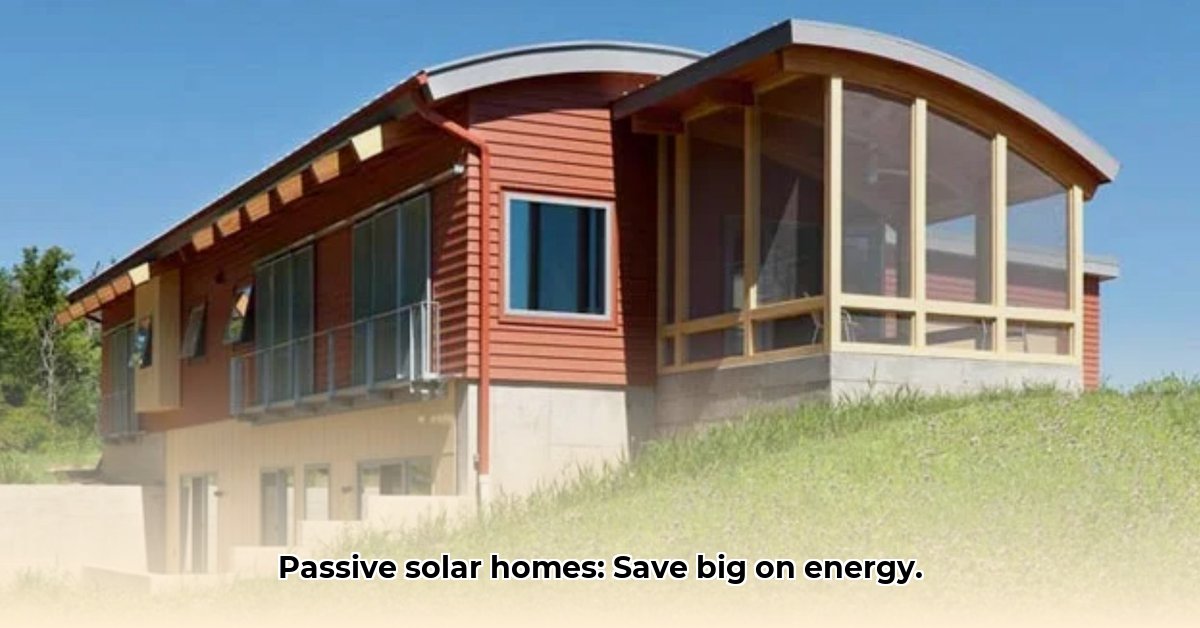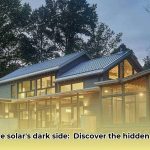Imagine slashing your energy bills and basking in the warmth of a sun-drenched home, all thanks to the power of the sun! This comprehensive guide unveils the secrets of passive solar energy, empowering you to design a home that harnesses the sun’s natural power. From fundamental principles to practical tips and inspiring real-world examples, you’ll discover everything you need to know, whether you’re embarking on a new construction project or breathing new life into your existing home. Let’s embark on a journey to create a sustainable, energy-efficient haven, powered by the sun – it’s simpler than you might think! For a comparison of passive and active systems, see this helpful resource: [Passive vs. Active](https://txgenco.com/passive-vs-active-solar-energy).
Delving into Passive Solar Energy: Understanding the Core Principles and Remarkable Benefits
Envision a home that effortlessly warms itself during the frosty embrace of winter and remains refreshingly cool throughout the scorching summer months, all while minimizing its reliance on costly and energy-guzzling heating and cooling systems. This is the captivating allure of passive solar energy. Far from being a futuristic fantasy, it’s a tangible reality achieved through the artful design of your home, harmonizing with the sun’s inherent power. Picture it as a brilliant, energy-saving design innovation, tapping into the boundless free energy offered by Mother Nature herself! Buckle up as we explore the inner workings of this phenomenon and uncover the myriad ways you can reap its rewards. By embracing passive solar design, you can substantially curtail energy consumption, shrink your home’s carbon footprint, and wholeheartedly embrace a more sustainable and eco-conscious lifestyle.
Unveiling the Core Principles: Capturing Sunlight, Harnessing Storage, and Embracing Smart Design
At its core, passive solar energy design revolves around the ingenious utilization of sunlight to your utmost advantage. This entails maximizing the influx of sunlight during the winter months to envelop your home in warmth while simultaneously minimizing its impact during the summer months to thwart overheating. To realize this delicate equilibrium, we require three indispensable key ingredients.
Foremost, we must ensure an ample supply of sunshine. Expansive windows – ideally oriented towards the south in the Northern Hemisphere and towards the north in the Southern Hemisphere – assume paramount importance. These windows function as colossal solar panels, enabling the sun’s radiant warmth to permeate your home during the cooler seasons. Southern exposure is indeed the keystone for optimal solar gain during the winter months.
Secondly, we must establish a mechanism to effectively store this captured solar energy. This is where thermal mass steps into the limelight. Envision thermal mass as nature’s prodigious battery. Materials such as concrete, brick, stone, or even water possess the remarkable ability to absorb heat during the day and gradually release it throughout the night. This process effectively mitigates temperature fluctuations, ensuring your home remains comfortably warm even after the sun has dipped below the horizon. Walls constructed from these materials operate as immense heat sinks, diligently absorbing and radiating heat throughout the day.
Lastly, we necessitate a sagacious strategy to retain heat within during winter and deflect it from entering during summer. This is achieved through the implementation of high-caliber insulation. Insulation functions as a thermal barricade, preventing heat from escaping during winter and impeding the ingress of warm air during summer. Picture it as a snug blanket enveloping your home in a cocoon of comfort. Augmenting this, the utilization of strategic shading devices, such as overhangs or awnings, thwarts the sweltering summer sun from directly assailing your windows, thereby maintaining a cooler interior ambiance. Proper shading, indeed, stands as a stalwart sentinel against overheating.
Navigating the Diverse Landscape of Passive Solar Design Strategies: Tailoring Approaches to Suit Varying Climates
It’s important to recognize that there isn’t a universal, one-size-fits-all solution when it comes to passive solar design. The most efficacious strategy hinges upon the specific climate you inhabit and the unique location of your home. Let’s explore three prevalent approaches:
- Direct Gain: The epitome of simplicity, this approach entails maximizing the direct influx of sunlight into your home through strategically positioned south-facing (in the Northern Hemisphere) windows. While effective, it necessitates meticulous consideration to forestall overheating during the summer months. The implementation of window coverings or other shading mechanisms may prove essential to regulate heat.
- Indirect Gain: Sunlight is channeled through a structure, such as a wall or roof, which subsequently heats a thermal mass (exemplified by a Trombe wall – a wall adorned with sun-facing glass and a thermal mass stationed behind it). The heat is then gradually released into your living area. This approach engenders a more consistent and gentle diffusion of warmth.
- Isolated Gain: Solar energy is harnessed to heat a discrete space, such as a sunroom or greenhouse, adjoined to your primary living area. The generated heat is then transferred to the main living area via vents or through the natural convection of air. This method affords greater command over heat distribution.
The selection of the appropriate strategy is of paramount importance. For instance, a dwelling nestled in the arid expanse of a desert will invariably necessitate a different approach compared to a home situated in a frigid, snow-laden climate. Consulting with a seasoned professional can prove invaluable in determining the optimal option tailored to your specific location. Climate considerations, undeniably, occupy center stage in passive solar design.
Passive Solar Material Selection: Striking the Optimal Equilibrium
The materials you opt to incorporate wield significant influence over the effectiveness of your passive solar home. Let’s embark on a comparative analysis of common options:
| Material | Pros | Cons |
|---|---|---|
| Concrete | High thermal mass, exceptional durability, relatively affordable | High embodied carbon (the carbon emitted during its production), relatively slow to heat up and cool down |
| Brick | Commendable thermal mass, aesthetically pleasing, reasonable pricing | Lower thermal mass compared to concrete, susceptibility to cracking, may necessitate more frequent maintenance |
| Stone | Excellent thermal mass, remarkable durability, natural aesthetic charm | Elevated cost, potentially high embodied carbon, challenging to manipulate during construction |
| Water | Exceptionally high thermal mass, capable of seamless aesthetic integration | Risk of leaks, mandates meticulous design and maintenance |
| Insulated Glass | Outstanding insulation value, effectively diminishes heat loss, reduces condensation | Higher initial cost compared to single-pane glass |
| Phase Change Materials (PCMs) | High thermal storage capacity, smaller space requirement, versatile applications | Can be expensive, potential for leakage, some PCMs may degrade over time |
Each material embodies a trade-off between thermal performance, economic considerations, and environmental ramifications. The embodied carbon of a material (the carbon emissions associated with its manufacturing and transportation) is progressively gaining prominence as a pivotal consideration for numerous home builders. Opting for sustainable materials underscores environmental conscientiousness.
Practical Passive Solar Considerations: Transcending the Realm of Materials
The efficacy of passive solar design transcends mere material selection. Air sealing assumes paramount importance in averting drafts and minimizing heat loss. The home’s orientation – its alignment relative to the sun’s trajectory – looms large in capturing the maximum solar energy. Astutely designed shading devices, such as overhangs or awnings, are indispensable for maintaining a cool interior milieu during summer.
While passive solar design endeavors to curtail your reliance on active heating and cooling systems, it’s imperative to acknowledge that supplemental heating, ventilation, and air conditioning (HVAC) may still prove necessary, particularly in regions characterized by extreme climates. Passive systems are conceived to minimize energy utilization, not eradicate it entirely. A well-integrated HVAC system stands as an essential complement.
A Step-by-Step Guide to Passive Solar Design Implementation
Note: This guide presents a general framework. Consulting with qualified professionals for site-specific design and implementation is always advisable.
- Site Analysis: Conduct a comprehensive assessment of your home’s location, encompassing its orientation towards the sun, prevailing wind patterns, and local climate intricacies. This appraisal serves as the cornerstone for determining the optimal placement of windows and other architectural attributes.
- Design Strategy Selection: Drawing upon your site analysis and climate insights, select the passive solar strategy (direct, indirect, or isolated gain) that aligns best with your unique requirements.
- Material Selection: Deliberate on the chosen strategy and budgetary constraints to meticulously select building materials that strike the ideal equilibrium between thermal mass and insulation.
- Building Envelope Design: Craft the design of your home’s exterior – encompassing walls, roof, and windows – to forge a well-insulated and air-tight envelope that minimizes energy wastage.
- Shading Strategy Implementation: Scrutinize and implement shading devices, encompassing overhangs, awnings, or exterior window coverings, to effectively regulate summer solar gain.
- HVAC System Integration: Ascertain whether supplemental HVAC systems will be requisite to furnish auxiliary heating and cooling as needed.
By internalizing and applying these guiding principles, you can substantially curtail your energy consumption, diminish your utility bills, and cultivate a more comfortable and environmentally sustainable home. Embracing passive solar energy represents a rewarding investment in your home’s energy efficiency and your unwavering commitment to environmental stewardship. Thoughtful planning stands as the bedrock for unparalleled energy efficiency.
Optimizing Passive Solar Home Design Across Diverse Climates and Building Codes
Key Takeaways:
- Passive solar design emerges as a potent force in mitigating energy consumption through the strategic deployment of sunlight, thermal mass, and judicious shading.
- Triumphant implementation necessitates a holistic methodology, encompassing proficient insulation, impeccable airtightness, and prudent material selection.
- Optimal strategies manifest considerable variance contingent upon the climate; how to optimize passive solar home design for varying climates and building codes emerges as pivotal for achieving success.
- Retrofitting existing homes presents a unique set of challenges compared to greenfield constructions.
- Sustainable materials exert a salubrious influence on both the effectiveness and the environmental ramifications.
Foundational Principles of Passive Solar Design
Passive solar design meticulously orchestrates the sun’s energy to naturally heat and cool your abode. It’s predicated on the strategic emplacement of windows, the judicious utilization of materials endowed with heat storage capabilities (thermal mass), and astute shading mechanisms to govern sunlight ingress. Consider your home as an intricate solar collector!
Visualize a south-facing wall (in the Northern Hemisphere) adorned with expansive windows. During the winter season, the sun’s attenuated angle permits copious sunlight to penetrate, thereby suffusing the interior with warmth. Materials like concrete, brick, or even water molecules dutifully absorb this heat, progressively releasing it throughout the nocturnal hours. This exemplifies thermal mass in its quintessential form. Conversely, during the summer months, the sun’s elevated angle is skillfully intercepted by strategically positioned overhangs or awnings, thereby precluding overheating. Insulation assumes the mantle of trapping warmth within during winter and preserving the cool air’s integrity during summer. It’s an exquisite equilibrium between solar gain and heat dissipation. Solar strategies are inextricably linked to sun angles.
Tailoring Design Strategies to Diverse Climatic Conditions
A panoply of design strategies warrants consideration:
- Direct Gain: Sunlight directly impinges upon and heats the living space. Simple and efficacious in temperate climates, but may precipitate overheating in hotter climes.
- Indirect Gain: Sunlight initially warms a thermal mass (such as a sunroom or Trombe wall) prior to permeating the living space with warmth. This engenders a more homogeneous temperature profile.
- Isolated Gain: Sunlight irradiates a segregated space (akin to a sunroom), which subsequently channels heat to the primary living area. This bestows superlative temperature regulation capabilities.
The selection of the optimal approach hinges upon the characteristics of your climate. A frigid climate stands to gain from maximized direct gain during winter, whereas a sweltering, humid climate necessitates robust insulation and astute shading to forestall overheating. How to optimize passive solar home design for varying climates and building codes pivots on discerning and implementing appropriate strategies. Climate-bespoke designs are indispensable.
Material Palette: Harmonizing Performance with Sustainability
Material selection assumes critical importance. Disparate materials exhibit disparate thermal attributes.
| Material | Pros | Cons |
|---|---|---|
| Concrete | Elevated thermal mass, enduring robustness, economic viability | Elevated embodied carbon footprint, protracted heating/cooling cycles |
| Brick | Salutary thermal mass, aesthetic merits, moderate cost | Diminished thermal mass relative to concrete, moderate cost |
| Stone | Exemplary thermal mass, enduring robustness | Elevated cost, substantial embodied carbon footprint |
| Water | Exceptional thermal mass, energy-efficient characteristics | Necessitates specialized systems, potential for leakage events |
| Insulated Glass | Elevated R-value (resistance to heat flow), mitigates heat efflux | Higher upfront expenditure |
| Rammed Earth | Excellent thermal mass, sustainable, low embodied carbon | Labor-intensive, requires specific soil types, may need stabilization |
When evaluating sustainable materials, accord due consideration to the embodied carbon (encompassing carbon emissions stemming from a material’s production lifecycle). Rammed earth or low-impact concrete epitomize exemplary eco-conscious alternatives. Sustainable materials curtail environmental repercussions.
Pragmatic Considerations for Peak Design
Beyond mere material facets, a constellation of additional factors exerts influence:
- Air Sealing: The meticulous application of air sealing protocols curtails drafts and heat dissipation.
- Orientation: Prioritize the placement of windows along a south-facing alignment (in the Northern Hemisphere).
- Shading Devices: Overhangs, awnings, and deciduous trees function as bulwarks against summer overheating.
- Supplemental HVAC: While passive solar strategies aspire to alleviate the dependence on HVAC systems, a meticulously engineered system stands ready to ensure comfort.
Exemplary Case Studies: Adaptability Across Climatic Boundaries
Veritable embodiments of passive solar homes grace a diverse spectrum of climates. The meticulous scrutiny of their design tenets furnishes invaluable insights into the versatility of these principles. As an illustrative instance, a dwelling nestled in a frigid climate might accentuate expansive south-facing windows and imposing thermal mass walls, whereas a domicile in a torrid climate might prioritize shading accoutrements, elevated thermal mass, and pervasive natural ventilation patterns. Designs adapt to mirror localized climatic nuances.
[Example Case Study Image Here] (Replace with actual image)
[Example Schematic Here] (Replace with actual schematic)
Passive Solar Design Strategies Adapted for Coastal Climates
Key Takeaways:
- Passive solar design proves instrumental in curtailing energy consumption within buildings.
- Astute site assessments coupled with climate-attuned strategies are indispensable precursors to triumphant implementation.
- A holistic mosaic encompassing design, materials, and operational protocols remains paramount.
- The judicious balance between heating and cooling strategies exhibits variance commensurate with climatic conditions.
- Further scholarly inquiry is warranted regarding passive solar’s proficiency in attenuating extreme weather phenomena.
Illuminating the Essence of Passive Solar Energy
Envision harnessing the sun’s boundless energy without enlisting the aid of clamorous, energy-ravenous contrivances. Such is the paradigm of passive solar design. It artfully leverages your home’s architectural blueprint and constituent materials to adeptly gather, sequester, and disseminate solar heat. Visualize your dwelling as an innate solar receptacle! This methodology begets diminished energy expenditures coupled with a more circumscribed carbon footprint. Are you primed to delve into enlightenment? Passive design begets curtailed energy outlays.
Foundational Tenets of Passive Solar Design
A coterie of cardinal tenets underpins efficacious passive solar design. Initially, south-facing glazing (windows) maximizes solar influx during the winter months. Concurrently, thermal mass—encompassing materials such as concrete, brick, or hydraulic elements—soaks up this energy and incrementally releases it during nocturnal hours. Consider it akin to a colossal, natural battery. Concomitantly, judicious insulation serves to stem heat efflux. And finally, strategically emplaced shading mechanisms (overhangs, awnings) thwart overheating during the summer months. Effective design hinges upon these keystone principles.
Orchestrating Design Strategies for Disparate Climatic Milieus
A panoply of strategies exist to optimize solar accrual premised upon climatic vagaries. Direct-gain systems exploit south-facing windows to directly irradiate the interior with heat. While laudable for milder climes, they may prove problematic in exceedingly hot or excessively frigid locales. Indirect-gain systems capitalize on a sun-bathed wall that absorbs thermal energy, subsequently radiating it into the domicile. This engenders amplified temperature modulation. Finally, isolated-gain systems enlist a sunspace (a thermally sequestered chamber) to ensnare solar heat prior to its dissemination. Passive Solar Design Strategies for Coastal Climates necessitate a nuanced tack, mindful of elevated humidity levels, maritime breezes, and cyclical temperature undulations. Coastal designs must harmonize with humidity dynamics.
Material Spectrum: Concord Between Performance and Sustainability
Judicious material selection holds paramountcy. High-performance glazing mitigates heat dissipation. The thermal attributes and embodied carbon footprint (encompassing the emissions stemming from manufacturing processes) must be subjected to scrupulous evaluation. Concrete and lithic elements boast heightened thermal mass yet concomitantly elevate embodied carbon footprints. Recycled constituents can assuage this impact. Insulation must demonstrate efficacy and robustness. Proper sealing thwarts atmospheric incursions and heat dissipation within your coastal abode. Material selections exert profound influence on building efficiency.
Pragmatic Design and Construction Ramifications
Air sealing assumes paramount importance, engendering diminished energy wastage. Sagacious building emplacement and shading mechanisms prove indispensable. Supplemental HVAC (heating, ventilation, and air conditioning) becomes imperative even within passively designed domiciles. Contemplate employing a heat pump, as this is much better than traditional systems. Precision and meticulous planning are of course essential.
Case in Point: A Coastal Passive Solar Abode
Visualize a domicile tailored for the nuances of a coastal climate, harnessing these principles to fulsome effect. Expansive south-facing fenestrations are outfitted with high-performance glazing, thereby amplifying solar yield during the winter season. Substantial concrete walls embody thermal mass, liberating sequestered heat during nocturnal hours. Solar irradiance during the summer season is adroitly interdicted via salient overhangs. These attributes, synergized with efficacious insulation and air sealing, demonstrably attenuate energy consumption. Coastal homes thrive under the aegis of passive design.
Phased Approach to Integrating Passive Solar Design
- Site Analysis: Encompasses assessment of solar trajectories, prevailing winds, and extant climatic data.
- Design Optimization: Orient the building to unlock maximal solar yield during the winter solstice while concurrently curtailing it during the summer solstice.
- Material Selection: Select congruous glazing, thermal mass, and insulation accoutrements.
- Shading Strategies: Imbue overhangs, awnings, or exterior shading appurtenances.
- Air Sealing: Implement thorough air sealing to mitigate atmospheric incursions and heat dissipation.
- HVAC Integration: Calibrate a high-efficiency HVAC apparatus as a precautionary measure.
Optimizing Passive Solar Heating Solutions in Cold Climates
Key Takeaways:
- Triumphant Optimizing Passive Solar Heating in Cold Climates necessitates a harmonious reconciliation between maximized winter solar heat acquisition and minimized summer overheating propensities.
- South-facing (Northern Hemisphere) orientation assumes cardinal significance in garnering winter solar influx.
- High thermal mass materials (i.e., brick, stone, concrete) sequester solar heat, progressively liberating it throughout nocturnal phases.
- Judicious insulation and air sealing methodologies mitigate heat diffusion.
- Optimal fenestration selection (SHGC between 0.45 and 0.57) proves indispensable.
- Scrupulous consideration of localized climatic nuances and microclimatic conditions looms large in achieving design apotheosis.
Demystifying the Underpinnings of Passive Solar Design Principles
Passive solar heating leverages the sun’s radiant energy to directly suffuse your domicile with warmth. Conceptualize it as nature’s pre-installed heating ecosystem. It hinges upon the strategic orchestration of your dwelling to optimize solar gain during winter and attenuate it during summer. Are you yearning for diminished energy bills coupled with an augmented sense of domestic well-being? Passive solar design stands as a compelling contender. Passive heating curtails energy overhead.
The core principles find elegant expression:
- Orientation: Position your domicile to capitalize on southern exposure (within the Northern Hemisphere) to achieve superlative solar irradiance during winter months.
- Glazing: Deploy expansive south-oriented windows to permit solar influx. Envision the deployment of triple-pane windows to garner superior insulation competencies.
- Thermal Mass: Materials such as concrete, brick, or stone adeptly absorb and sequester solar heat during diurnal phases, subsequently liberating it during nocturnal intervals.
- Insulation: Meticulous insulation provisions stand as the bulwark against heat diffusion. Air sealing assumes commensurate salience.
- Shading: Enlist overhangs, awnings, or deciduous arboreal cohorts to provide fenestral shading during summer, thereby curtailing unwanted heat accrual. Laudable designs optimize solar irradiance.
Strategizing for Disparate Passive Solar Methodologies
A constellation of strategies synergistically amalgamates these tenets. Allow us to dissect three prevalent methodologies:
- Direct Gain: Solar irradiation directly penetrates the living space, thereby heating both it and the adjoined thermal mass. Deceptively simplistic, it is prone to instigating overheating events absent judicious management.
- Indirect Gain: Solar radiation initially warms a thermal mass (e.g., a sunroom), from which thermal energy subsequently permeates living concourses. This yields a more attenuated temperature diffusion profile.
- Isolated Gain: Solar radiation warms a segregated space (exemplified by a sunroom or an annexed greenhouse), which then indirectly imparts thermal energy to the adjacent dwelling. This approach demonstrates remarkable efficacy in frigid climes, albeit necessitating heightened planning acumen.
Navigating the Material Spectrum: Achieving Equilibrium
The materials you elect to incorporate wield significant influence over your dwelling’s passive solar performance indices. Deliberate on these interwoven considerations:
| Material | Thermal Mass | Insulation | Cost | Embodied Carbon |
|---|---|---|---|---|
| Concrete | High | Low | Moderate | Moderate |
| Brick | High | Moderate | Moderate | Moderate |
| Stone | High | Moderate | High | High |
| Water (PEX tubing) | Moderate | Low | Moderate | Low |
| Insulated panels | Low | High | Moderate | Moderate |
Where SHGC is Solar Heat Gain Coefficient.
Pragmatic Considerations for Frigid Climes
Orchestrating passive solar solutions to function efficaciously during winter mandates scrupulous planning:
- Air Sealing: Ameliorate atmospheric incursions by hermetically sealing all gaps extant within your domicile’s envelope.
- Window Placement and Design: Optimize for south-oriented fenestrations while cogently diminishing north-oriented counterparts. Envision triple-pane configurations calibrated with a congruous SHGC.
- Overhang Design: Precisely compute overhang expanse to strategically interdict summer solar irradiation while concurrently sanctioning winter solar penetration. (Consult building software or engage subject matter experts for precise computations).
- Supplemental HVAC: Passive solar provisions are rarely self-sufficient; instead, harmonize them with a high-efficiency HVAC ecosystem.
Exemplar of a Triumphant Passive Solar Domicile within a Frigid Clime
Bear in mind that Optimizing Passive Solar Heating in Cold Climates pivots on assiduous design protocols, sagacious material selection, and a profound cognizance of the complex interplay between solar irradiance and your domicile’s architectural attributes. This represents an investment poised to yield dividends in the form of sustained energy savings, augmented domestic comfort, and a curtailed environmental impact for decades hence. Frigid climes stand to reap appreciable energy dividend.
- Fun Facts About Hydroelectric Energy You Might Not Know - January 7, 2026
- Fun Facts About Hydropower And How Water Makes Electricity - January 6, 2026
- Hydro Power Everyday Keeps Lights On and Water Flowing - January 5, 2026
















